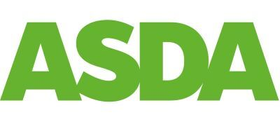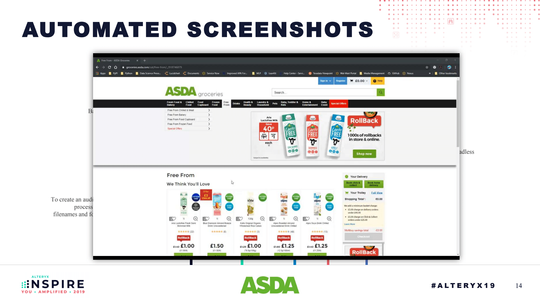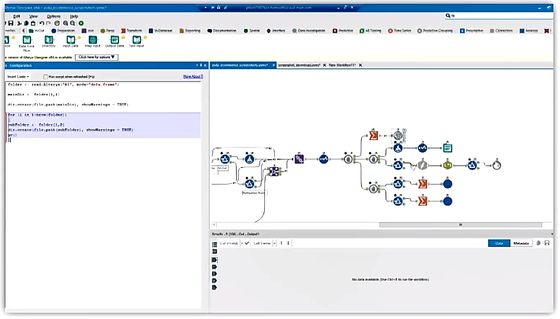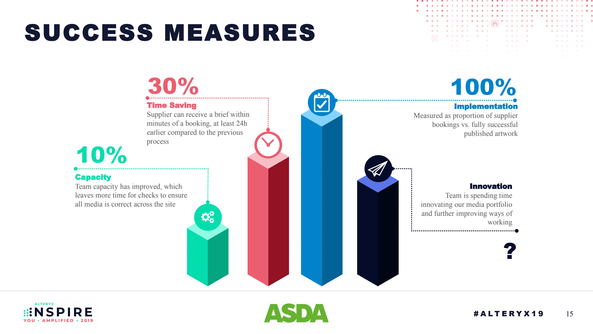Maveryx Success Stories
Learn how Alteryx customers transform their organizations using data and analytics.STORIES WANTED
Showcase your achievements in the Maveryx Community by submitting a Success Story now!
SUBMISSION INSTRUCTIONS- Community
- :
- Community
- :
- Learn
- :
- Success Stories
- :
- Media and Machine Learning
Media and Machine Learning
- Subscribe to RSS Feed
- Mark as New
- Mark as Read
- Bookmark
- Subscribe
- Printer Friendly Page
- Notify Moderator

Overview of Use Case:
ASDA is a British supermarket retailer, headquartered in Leeds, West Yorkshire. This use case shows how ASDA used Alteryx to manage their media asset data and implement machine learning to categorize their customer feedback from their website. Overall, Alteryx’s functionality helped the team generate cost savings of $1 million by providing them the ability to complete these projects independently.
Describe the Business Challenge Problem
Describe the Business Challenge Problem
The ASDA Media Management (AMM) project was a complex structure of internal and external data captures, that examined the process of interactions with customers, and suppliers booking spaces on the ASDA website. The team had spent a lot of resources planning the project components and developing a vision for it. They asked external vendors to help quantify the cost to deploy this project and they were quoted at $1 million.
Managing data assets with constraints such as:
- Data is inputted manually everywhere
- SharePoint record upload limitation
- No effective way to track banner bookings
The previous process:
- Collected spreadsheets and files from everywhere and slowly uploaded them
- Used Excel to track banner requests and communications
The new process with Alteryx:
- Automated
- Standardizing and Centralizing Data Storage
- Making the ASDA website a data asset
Describe your Working Solution
Rather than spending $1 million on AMM, ASDA decided to complete this project themselves using Alteryx and a handful of other technologies. ASDA created a global instance for all media assets both in physical stores and online. Their suppliers were primarily booking banners on their website and through their external SharePoint, whereas the interaction with the online piece of design flows and approval of the trials were happening through email and were manually entered in spreadsheets. ASDA didn’t have a uniform repository of knowledge to track any of this media asset data.
ASDA addressed this problem by restructuring their enterprise system architecture and positioned Alteryx right at the center. They refer to Alteryx as their ‘orchestration’ layer since it permits ASDA to connect Salesforce, SharePoint and their other enterprise software data.

The AMM project needed an enhancement of the existing data capture process and the removal of manual spreadsheet input. The team used the Summarize tool to group and concatenate related fields, they leveraged the Spatial Process tool to add text to columns split rows and the SharePoint List Input tool to absorb large amounts of information to upload to SharePoint and bypass the 5,000 record limit they’d initially dealt with. The ASDA team interacts with hundreds of suppliers through their SharePoint but previously they had no reliable way to monitor or verify that activity. Now, they upload and receive files with a two-step authentication process developed in an Alteryx workflow. This authentication process required a combination of Download tools, and certain restful API endpoints to allow for folder nesting and data hierarchies.

Another requirement for the project was creating an automated capture for when banners are deployed on the website. This involves a full web screen capture, including the full height of the website and any combined sequence of displayed products. The challenge was that the backend system that feeds the website is file-based technology, using XML and JSON and there is no quarriable data footprint. There isn’t a standardized solution out there for this problem. The below image is an example of a banner on the ASDA website. The page contains three rows of products and the goal was to capture all of this dynamically. They’re media assets that are powered through Adobe Scene7 integration.

In ASDA’s case, the backend footprint exposed through those XML and JSON files gave the team an opportunity to develop their own custom solution by utilizing a Web Distributed Authoring and Versioning tool (WEBDAV) called CyberDuck. With WEBDAV they developed a workaround and the Alteryx (XML and JSON) Parse tools made it possible to organize the data tasks; the outcome is a quarriable data set and the screengrab is now auto-created through Alteryx automation. ASDA is leveraging AI to recreate the folder structure that denotes the timestamps of these banners and the structure of the website to place those banner files in for reference.

The final step in ASDA’s Alteryx journey was using machine learning as a way to understand and utilize customer feedback more effectively, they titled this project Customer to Engineering (C2E). They utilized data from their round the clock (24/7) customer support center to request customer feedback for any number of hours. They did a time series analysis of the data using support vector machines for training, and they’re trying to identify moments where a higher number of problems occur for customers on their website.

They used Service Now APIs to provide their engineering team the customer technical feedback as it came in and they incorporated a feedback loop integration, where they ask online merchandisers to assess the quality of their predictions. This AI process is cloud-based, ASDA relies on Microsoft Azure and Google Cloud, GCP. And it includes aspects of collaboration, connectivity, just like Alteryx.
ASDA is primarily leveraging Python run time through Jupiter notebook while using a method called Grid Search Machine learning. Its where the selection of the model is your first decision, like hyperparameter modeling. Rather than executing those tasks one at a time, it’s parametrizing those matrices to scan through every possible combination permutation of those settings and allows for high accuracy scores. This is dictated by the ground truth data, if the team were to hide some of this data, they can then evaluate the model’s accuracy performance against the original score and arrive at a result.

Describe the benefits you have achieved
Roi and Benefits
- $1 million saved
- Removed risk of manual data error
- 5% increase in Profit and Loss (P&L)
- Automation to verify irregularities in feedback and website performance
- Innovation: employees spend less time on menial assignments and more time developing insights and solutions to customer feedback
Personalization wasn't an original requirement, but through Power Apps and record-level access, they are now able to provide different record sets and perspectives to internal colleagues looking at design, approval, and publishing aspects of ASDA’s workflows. Alteryx improved implementation rates and the ASDA team can now finally integrate feedback into their banner booking strategy. And with the authentication workflow capability, ASDA can now create folders for communications quickly at scale and archive historical supplier and banner information by transferring data into Teradata and flat flies for historical reference. Lastly, one of the greatest benefits the team got out of Alteryx and the C2E project was being proactive in creating insights rather than being reactive.
-
Adobe
2 -
Alteryx Connect
5 -
Alteryx Designer
202 -
Alteryx for Good
1 -
Alteryx Promote
2 -
Alteryx Server
66 -
Alteryx using Alteryx
29 -
Americas
158 -
Analyst
108 -
Analytics Leader
54 -
Asia Pacific
29 -
AWS
9 -
BI + Analytics + Data Science
100 -
Business Leader
37 -
C-Leader
18 -
Data Prep + Analytics
230 -
Data Science + Machine Learning
113 -
Data Scientist
14 -
Department: Other
14 -
Education
18 -
Energy + Utilities
5 -
Europe + Middle East + Africa
58 -
Experian
2 -
finance
29 -
Financial Services
33 -
Healthcare + Insurance
21 -
Human Resources
19 -
Information Technology
25 -
IT
31 -
Life Sciences + Pharmaceuticals
3 -
Manufacturing
20 -
Marketing
16 -
Media + Entertainment
12 -
Microsoft
52 -
Operations
38 -
Other
10 -
Process Automation
59 -
Professional Services
69 -
Public Sector
15 -
Qlik
1 -
Retail + CPG
32 -
Sales and Service
24 -
Salesforce
9 -
SAP
11 -
Snowflake
6 -
Tableau
71 -
Tech Partner: Other
86 -
Technology
34 -
Telecommunications
5 -
Teradata
5 -
Thomson Reuters
1 -
Transportation + Logistics
25 -
Travel + Hospitality
4 -
UiPath
1
- « Previous
- Next »
